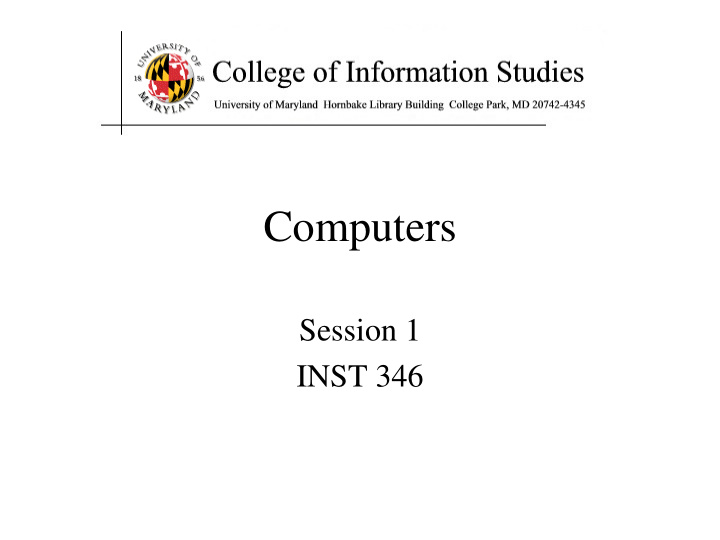



Computers Session 1 INST 346
Agenda • The Computer • The Course
Source: Wikipedia
Source: Wikipedia
Source: Wikipedia
Source: Wikipedia
The Big Picture Memory Processor Network
Hardware Processing Cycle • Input comes from somewhere – Keyboard, mouse, microphone, camera, … • The system does something with it – Processor, memory, software, network, … • Output goes somewhere – Monitor, speaker, robot controls, …
What’s that?
Frequency Unit Abbreviation Cycles per second hertz Hz 1 10 3 = 1,000 kilohertz KHz 10 6 = 1,000,000 megahertz MHz 10 9 = 1,000,000,000 gigahertz GHz Time Unit Abbreviation Duration (seconds) second sec/s 1 10 -3 = 1/1,000 millisecond ms µ s 10 -6 = 1/1,000,000 microsecond 10 -9 = 1/1,000,000,000 nanosecond ns 10 -12 = 1/1,000,000,000,000 picosecond ps 10 -15 = 1/1,000,000,000,000,000 femtosecond fs
More cores!
System Architecture Keyboard Mouse Sound Video Card Input Card Controller System Bus Front Side Bus Hard CD/ L2 USB Port RAM CPU Drive DVD L1 Cache Motherboard
Source: Wikipedia
Units of Size Unit Abbreviation Size (bytes) bit b 1/8 byte B 1 2 10 = 1024 kilobyte KB 2 20 = 1,048,576 megabyte MB 2 30 = 1,073,741,824 gigabyte GB 2 40 = 1,099,511,627,776 terabyte TB 2 50 = 1,125,899,906,842,624 petabyte PB
Moore’s Law • Processing speed doubles every 18 months – Faster CPU, longer words, larger cache, more cores • Cost/bit for RAM drops 50% every 12 months – Less need for “virtual memory”
Extracted From Shelly Cashman Vermatt’s Discovering Computers 2004
Input Devices • Text – Keyboard , optical character recognition – Speech recognition, handwriting recognition • Direct manipulation – 2-D: mouse , trackball, touchpad, touchscreen – 3-D: wand, data glove • Remote sensing – Camera, speaker ID, head tracker, eye tracker
Binary Data Representation Example: American Standard Code for Information Interchange (ASCII) 01000001 = A 01100001 = a 01000010 = B 01100010 = b 01000011 = C 01100011 = c 01000100 = D 01100100 = d 01000101 = E 01100101 = e 01000110 = F 01100110 = f 01000111 = G 01100111 = g 01001000 = H 01101000 = h 01001001 = I 01101001 = i 01001010 = J 01101010 = j 01001011 = K 01101011 = k 01001100 = L 01101100 = l 01001101 = M 01101101 = m 01001110 = N 01101110 = n 01001111 = O 01101111 = o 01010000 = P 01110000 = p 01010001 = Q 01110001 = q … …
Output Devices • Visual – Screen, projector, head-mounted display, CAVE • Acoustic – Speakers, headphones • Physical – Tactile (vibrotactile, pneumatic, piezoelectric) – Force feedback (pen, joystick, exoskeleton) – Thermal • Vestibular (motion-based simulators) • Locomotive (treadmill, stationary bicycle) • Olfactory
Agenda • The Computer The Course
A Personal Approach to Learning • Work ahead, so that you are never behind • Find new questions everywhere – Then find the answers somewhere • Enrich your practical skills relentlessly • Pick topics you want to learn more about
The Fine Print • Group work is encouraged on homework – But you must personally write what you turn in • Deadlines are firm and sharp – Allowances for individual circumstances are included in the grading computation • Academic integrity is a serious matter – No group work during the exam! – Scrupulously respect time limits
Before You Go On a sheet of paper, answer the following (ungraded) question (no names, please): What was the muddiest point in today’s class?
Recommend
More recommend